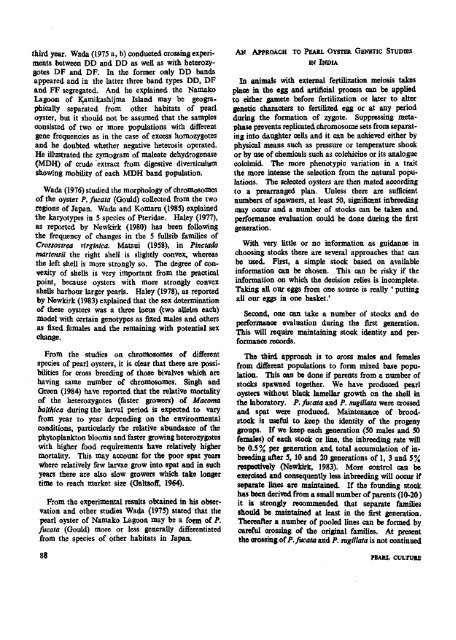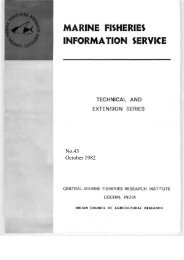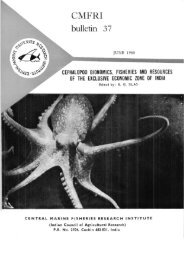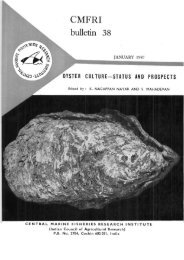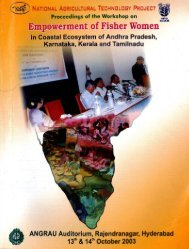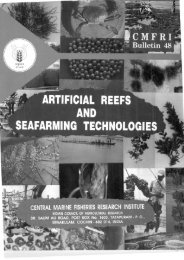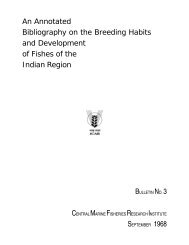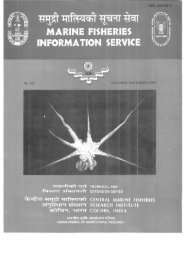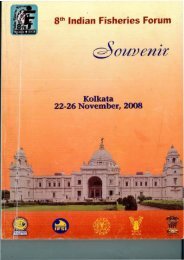pearl culture - Eprints@CMFRI - Central Marine Fisheries Research ...
pearl culture - Eprints@CMFRI - Central Marine Fisheries Research ...
pearl culture - Eprints@CMFRI - Central Marine Fisheries Research ...
Create successful ePaper yourself
Turn your PDF publications into a flip-book with our unique Google optimized e-Paper software.
third year. Wada (1975 a, b) conducted crossing experimentsbetween DD and DD as well as with beterozygotesDF and DF. In the former only DD bandsappeared and in the latter three band types DD, DFand FF segregated. And he explained the NamakoLagoon of Kamikashijma Island may be geographicallyseparated from other habitats of <strong>pearl</strong>oyster, but it should not be assumed that the samplesconsisted of two or more populations with differentgene frequencies as in the case of excess homozygotesand he doubted whether negative heterosis operated.He illustrated the zymogram of maleate dehydrogenase(MDH) of crude extract from digestive diverticulumshowing mobility of each MDH band population.Wada (1976) studied the morphology of chromosomesof the oyster P. fucata (Gould) collected from the tworegions of Japan. Wada and Komaru (1985) explainedthe karyotypes in 5 species of Pteridae. Haley (1977),as reported by Newkirk (1980) has been followingthe frequency of changes in the 5 fuUsib families ofCrossostrea virginica. Matsui (1958), in Pinctadamartensii the right sheU is slightly convex, whereasthe left shell is more strongly so. The degree of convexityof shells is very important from the practicalpoint, because oysters with more strongly convexshells harbour larger <strong>pearl</strong>s. Haley (1978), as reportedby Newkirk (1983) explained that the sex determinationof these oysters was a three locus (two alleles each)model with certain genotypes as fixed males and othersas fixed females and the remaining with potential sexchange.From the studies on chromosomes of differentspecies of <strong>pearl</strong> oysters, it is clear that there are possibilitiesfor cross breeding of those bivalves which arehaving same number of chromosomes. Singlh andGreen (1984) have reported that the relative mortalityof the heterozygotes (faster growers) of Macomabalthica during the larval period is expected to varyfrom year to year depending on the environmentalconditions, particularly the relative abundance of thephytoplankton blooms and faster growing heterozygoteswith higher food requirements have relatively highermortality. This may account for the poor spat yearswhere relatively few larvae grow into spat and in suchyears there are also slow growers which take longertime to reach market size (Galtsoff, 1964).From the experimental results obtained in his observationand other studies Wada (1975) stated that the<strong>pearl</strong> oyster of Namako Lagoon may be a form of P,fucata (Gould) more or less generally differentiatedfrom the species of other habitats in Japan.AKAPPROACH TO PEARL OYSTER GENETIC STUDIESIN INDIAIn animals with external fertiUzation meiosis takesplace in the egg and artificial process can be appUedto either gamete before fertilization or later to altergenetic characters to fertilized egg or at any periodduring the formation of zygote. Suppressing metaphaseprevents replicated chromosome sets from separatinginto daughter cells and it can be achieved either byphysical means such as pressure or temperature shockor by use of chemicals such as colchicine or its analoguecoldmid. The more phenotypic variation in a traitthe more intense the selection from the natural populations.The selected oysters are then mated accordingto a prearranged plan. Unless there are suflBcientnumbers of spawners, at least 50, significant inbreedingmay occur and a number of stocks can be taken andperformanoe evaluation could be done during the firstgeneration.With very little or no information as guidance inchoosing stocks there are several approaches that canbe used. First, a simple stock based on availableinformation can be chosen. This can be risky if theinformation on which the decision relies is incomplete.Taking all our eggs from one source is really ' puttmgall our eggs in one basket.'Second, one can take a number of stocks and doperformance evaluation during the first generation.This will require maintaining stock identity and performancerecords.The third approach is to cross males and femalesfrom different populations to form mixed base population.This can be done if parents from a number ofstocks spawned together. We have produced <strong>pearl</strong>oysters without black lamellar growth on the shell inthe laboratory. P. fucata and P. sugillata were crossedand spat were produced. Maintenance of broodstockis useful to keep the identity of the progenygroups. If we keep each generation (50 males and 50females) of each stock or line, the inbreeding rate willbe 0.5 % per generation and total accumulation of inbreedingafter 5, 10 and 20 generations of 1, 3 and 5%respectively (Newkirk, 1983). More control can beexercised and consequently less inbreeding will occur ifseparate lines ate maintamed. If the founding stockhas been derived from a small number of parents (10-20)it is strongly recommended that separate familiesshould be maintained at least in the first generation.Thereafter a number of pooled lines can be formed bycareful crossing of the original families. At presentthe crossing of jP./i


